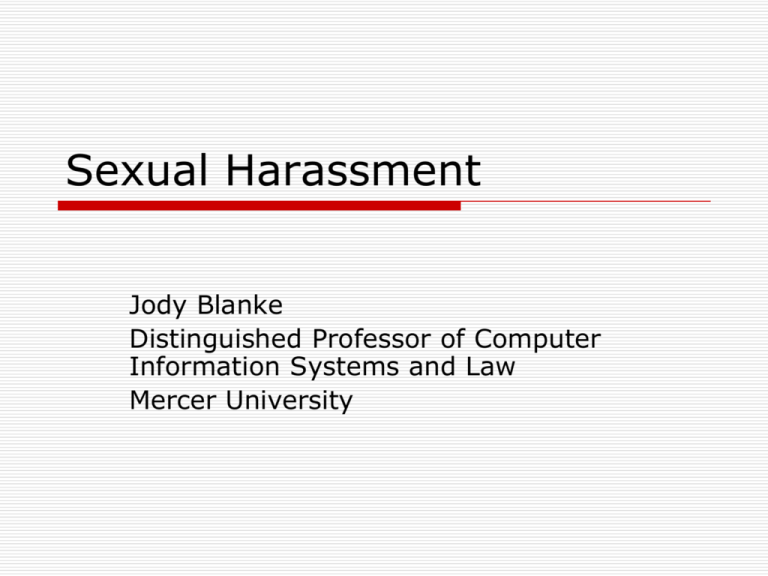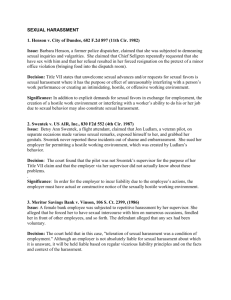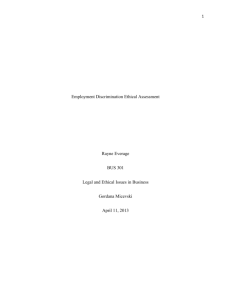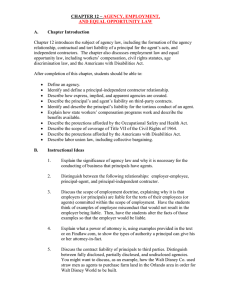
Sexual Harassment
Jody Blanke
Distinguished Professor of Computer
Information Systems and Law
Mercer University
Sexual Harassment
Quid Pro Quo Harassment
Employee is required to engage in sexual activity in
exchange for promotions, raises or continued
employment
Hostile Environment Harassment
The harassment is unwelcome activity
The harassment is based upon gender
The harassment is sufficiently severe or pervasive to create
an abusive working environment
The harassment affects a term or condition of employment
The employer had actual or constructive notice of the hostile
environment and took no prompt or adequate remedial action
2
Meritor Savings Bank v.
Vinson (1986)
Supreme Court upheld sexual harassment claim
despite absence of concrete economic effect on
employment or loss of tangible job benefits
Employee had given in to supervisor’s sexual
advances and had a sexual relationship for several
years. Supervisor fondled her in front of other
employees, followed her into the women’s restroom
and forcibly raped her on several occasions.
Activities ceased after employee had a steady
boyfriend.
Court held that in light of the “record as a whole” and
the “totality of the circumstances,” there was an
actionable “hostile environment” sexual harassment
claim.
3
Harris v. Forklift Systems (1993)
Supreme Court found that a hostile environment
did exist for a female manager.
President of company :
Said “You’re a woman, what do you know?”
Said “We need a man as the rental manager.”
Said that she was “just a dumb ass woman.”
Asked in her in front of others “What did you do,
promise the guy … some [sex] Saturday night?”
Asked her if she wanted to “go to the Holiday Inn to
negotiate her raise.”
Asked female employees to retrieve coins from his
front pants pockets.
4
Employer Liability
Employers are vicariously liable under the doctrine of
respondeat superior for all torts committed by
employees acting within the scope of employment.
Employers may also be liable for torts committed by
employees not working within the scope of
employment if
the employer intended the conduct,
the employee’s high rank makes him the employer’s
alter ego,
the employer was negligent, or
the employee was aided in accomplishing the tort by
the existence of the agency relation.
5
Employer Liability
Employers are strictly liable for quid pro quo
sexual harassment, i.e., when there are
tangible employment actions taken.
Employers are not strictly liable if there is no
tangible employment action.
In these hostile environment cases, the employer can
use the Faragher/Ellerth defense to show that it had
a reasonable antidiscrimination policy in place, but
that the harassed employee unreasonably failed to
use it.
6
Faragher v. Boca Raton (1998)
Supreme Court found the city
(employer) liable for the sexual
harassment of its lifeguard supervisors.
Court held that while the city had
available to it an affirmative defense to
show that it exercised reasonable care
to prevent and correct promptly any
sexually harassing behavior, it had failed
to do so as a matter of law.
7
Burlington Ind. v. Ellerth (1998)
Supreme Court held that employer might be liable for hostile work
environment, but should have an opportunity to prove that employee
unreasonably failed to take advantage of employer’s complaint procedure.
Employee suffered no tangible employment action (and was even
promoted during her employment).
Employee worked for employer for about 15 months, but didn’t report
the harassment until a few weeks after leaving.
Her supervisor had made remarks about her breasts, had told her
top “loosen up” and warned, “you know, Kim, I could make your
life very hard or very easy at Burlington.”
He told her she was not “loose enough” and reached over and
rubbed her knee.
He responded to a job-related question from her, “I don’t have
time for you right now, Kim – unless you want to tell me what
you’re wearing.” A couple of days later, he again responded, “are
you wearing shorter skirts yet, Kim, because it would make your
job a whole heck of a lot easier.”
8
Policies
It is important to
It is important to
employees about
It is important to
policy
have a policy
inform
the policy
enforce the









